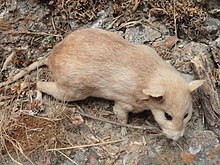| Dusky-footed woodrat | |
|---|---|

| |
| Scientific classification | |
| Domain: | Eukaryota |
| Kingdom: | Animalia |
| Phylum: | Chordata |
| Class: | Mammalia |
| Order: | Rodentia |
| Family: | Cricetidae |
| Subfamily: | Neotominae |
| Genus: | Neotoma |
| Species: | N. fuscipes
|
| Binomial name | |
| Neotoma fuscipes Baird, 1858
| |



The dusky-footed woodrat (Neotoma fuscipes) is a species of nocturnal rodent in the family Cricetidae.[2] Nicknames include "packrats" or "trade rats" because of their tendency to hoard things, build large domed dens, and "trade" by dropping then picking up another object for it. Coyotes and other predators will attempt to prey on these rodents by laying waste to the dens, but the sheer volume of material is usually dissuasive. Occasionally, dusky-footed woodrats will build satellite dens in trees. Although these animals are solitary, except in the mating season (when they are most vulnerable to predation), dens are frequently found in clusters of up to several dozen, forming rough "communities". The mating system in this species appears to be variable, with promiscuity most generally at high population densities and monogamy at lower densities.[3]
They are similar in appearance to the common rat species Rattus rattus and Rattus norvegicus, but with larger ears and eyes, softer coats, and furred tails. The California mouse, Peromyscus californicus, which has similar distribution, is sometimes found living in woodrat dens. Dens contain a nest and one or more "pantry" chambers which are used to store leaves and nuts for future consumption. The dental formula of Neotoma fuscipes is 1.0.0.31.0.0.3 × 2 = 16.[4]
- ^ Cassola, F. (2016). "Neotoma fuscipes". IUCN Red List of Threatened Species. 2016: e.T14587A22371665. doi:10.2305/IUCN.UK.2016-2.RLTS.T14587A22371665.en. Retrieved 11 November 2021.
- ^ Musser, G. G. and Carleton, M. D. (2005). "Superfamily Muroidea". in Mammal Species of the World a Taxonomic and Geographic Reference. D. E. Wilson and D. M. Reeder (eds.) pp. 894–1531. Johns Hopkins University Press, Baltimore.
- ^ McEachern, M. B.; McElreath, R. L.; VanVuren, D. H. & Eadie, J. M. (2009). "Another genetically promiscuous 'polygynous' mammal: mating system variation in Neotoma fuscipes". Animal Behaviour. 77 (2): 449. doi:10.1016/j.anbehav.2008.10.024. S2CID 4953336.
- ^ Carraway, L. N.; Verts, B. J. (1991-11-06). "Neotoma fuscipes". Mammalian Species (386): 1–10. doi:10.2307/3504130. ISSN 0076-3519. JSTOR 3504130.
